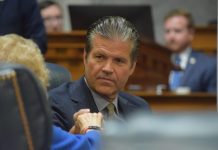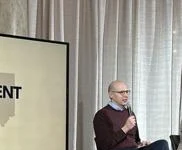By Ashlyn Myers, TheStatehouseFile.com
INDIANAPOLIS—Advocates from multiple health-care and state organizations testified before lawmakers Thursday as they worked through issues on the state’s next budget.Â
Lawmakers from both parties of the Senate and House gathered in a small, cramped room on the fourth floor of the Indiana Statehouse to hear testifiers share their final concerns with Indiana’s financial priorities.
After passing amendments in both chambers, the budget bill, House Bill 1001, went to a conference committee, giving representatives and senators one final chance to iron out their disagreements. This comes after Wednesday’s budget forecast revealed lawmakers have over $1.5 billion in extra state revenue to decide what to do with.
At the beginning of the meeting, Sen. Ryan Mishler, R-Mishawaka, revealed that he and other legislators had worked until 11:30 p.m. Wednesday trying to come to an agreeable final budget proposal.Â
Rep. Greg Porter, D-Indianapolis, joked that while he wasn’t at the Statehouse quite so late, House Democrats still had some requests for the budget.Â
“[The revenue forecast] means we have more opportunities to do more for individuals, residents of the great state of Indiana,†Porter said. “There are a lot of programs that are out there that we’re not funding in regards to SB 1 and 4 and 1422 dealing with Alzheimer’s. And we just hope that we will seriously look at those, those programs.â€
Just days ago, Porter held a press conference to share his caucus’ proposed changes to the budget, which included more money for health care and K-12 education.Â
Testimony requestsÂ
Starting testimony, Chris Daley, executive director of the Indiana Association of Resources and Child Advocacy, urged lawmakers to look into his organization’s request for a $30 million workforce stabilization grant for child and family welfare agencies across Indiana.Â
“We do know that children are sleeping in DCS offices again and staying in other unlicensed facilities,†Daley said. “Children are being placed far from home, and families in the community are having to wait for reunification because of the waitlist for services. All of that is due to the workforce.â€
David Sklar, director of government affairs with the Alzheimer’s Association Greater Indiana Chapter, echoed Porter’s request to assist the Alzheimer’s community in the Hoosier state.Â
His request is to fully fund House Bill 1422 at $1.5 million a year, which would establish a dementia care specialist program. According to Sklar, over 110,000 Hoosiers currently live with Alzheimer’s disease.Â
“It would be the first direct investment both at the state level and around the state in a program specifically meant to address Alzheimer’s,†Sklar said. “Obviously, we have a number of programs that support living with Alzheimer’s and dementia, but this would be the first direct investment from the state in confronting that disease.â€
Amanda Musser, a registered nurse and administrator for Homepoint Healthcare of Indiana, said the nursing field is “experiencing a crisis.†She said the state needs to allocate funds for long-term care patients to stay in their homes, which would ultimately save Indiana more money.Â
Musser said that in 2018, one of her patient’s hospital stays cost the state $15,293.63 a day. Caring for the patient at home would instead have cost $391.76 a day.
“As you know, long-term care is super expensive, and plus it’s been proven that 75% of people want to stay in the home,†Musser said. “So we would just like to have a little extra help to make sure that we can provide care for those people and make sure this is successful.â€
Tim Maloney, senior policy director for the Hoosier Environmental Council, requested that the budget fund Gov. Eric Holcomb’s request for more trails and land conservation.
“His proposal was for $25 million over the biennium for land conservation with the President Harrison Conservation Trust and $50 million for trails,†Maloney said. “I just encourage you to not see these as luxuries or as optional programs but really essential elements to our quality of life, to Hoosiers’ physical and mental wellbeing, to our economic wellbeing.â€
Maloney said outdoor recreation contributes almost $13 billion a year to the economy, making it a valuable beneficiary of the budget’s funds.Â
Lawmaker input
Sen. Eddie Melton, D-Gary, shared his party’s desire to fully fund health-care bills Senate Bill 1 and Senate Bill 4. He also said he wanted to look into funding Martin University, Indiana’s only predominantly Black institution, and its $2 million request.Â
In addition, Sen. Fady Qaddoura, D-Indianapolis, said he wants to see more funding for infrastructure across the state.Â
“There’s an opportunity with the revenue forecast to do more potentially with the community crossings program or the infrastructure funding formula to be sure that our communities are benefiting from good infrastructure,†Qaddoura said.Â
He also called for more transparency when looking into the Indiana Economic Development Corporation’s (IEDC) spending, so that Indiana’s taxpayers will “not be surprised with projects that get funded but the employment and the jobs don’t come with those opportunities.â€
Rep. Jack Jordan, R-Bremen, shared that he’s happy with the Senate’s idea to move around some of IEDC’s funding.Â
“There’s a significant amount of money going to IEDC, and as a rural state, I appreciated the proposal that the Senate came up with—a percentage being directed to economic activity to rural counties,†Jordan said. “So I just want to reemphasize my support for that fine work from our senators.â€
The committee will have to meet again to nail down the budget’s final version, taking today’s testimony into account.





